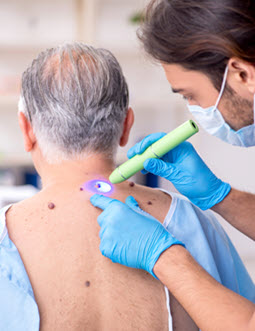Consult with a certified mohs surgery expert for precise and effective skin cancer removal.
Consult with a certified mohs surgery expert for precise and effective skin cancer removal.
Blog Article
Browsing Skin Cancer Therapy: The Necessary Function of Mohs in Modern Dermatology Practices
Skin cancer, a daunting diagnosis, typically leaves patients grappling with many treatment options. As we discover the intricacies of this treatment, one will appreciate its critical role in skin cancer therapy.
Recognizing Skin Cancer: Types and Dangers
Skin cancer cells, a possibly serious ailment, is even more common than lots of people realize. This disease, brought on by the unrestrained development of abnormal skin cells, mostly arises from DNA damages as a result of direct exposure to the sun and ultraviolet (UV) light. There are 3 main kinds of skin cancer cells: Basic cell cancer, Squamous cell carcinoma, and Melanoma. While the former 2 are much less dangerous and compose the majority of diagnosed situations, cancer malignancy is one of the most unsafe. It accounts for only regarding 1% of skin cancer situations yet creates the substantial majority of skin cancer deaths - skin cancer. Threat variables consist of reasonable skin, background of sunburn, too much sunlight direct exposure, living at high elevations or near the equator, having several moles, a family background of skin cancer cells, and weakened immune system.
What Is Mohs Surgical procedure and Just How It's Changing Skin Cancer Cells Treatment
In spite of the countless treatments presently offered for skin cancer, Mohs surgery stands out as a groundbreaking and very reliable option. Named after Frederic E. Mohs, the doctor who developed the procedure, Mohs surgical treatment is a specific surgical technique used to deal with skin cancer cells. This level of accuracy, combined with the ability to spare as much healthy and balanced cells as feasible, is transforming skin cancer cells therapy.
The Advantages of Mohs Surgical Procedure Over Typical Skin Cancer Treatments
Structure on the ingenious nature of Mohs surgical procedure, it's important to consider its many advantages over typical skin cancer cells treatments. Unlike guidelines, Mohs provides a greater cure rate, frequently getting to 99% for newbie treatments and 94% for persistent cancers cells. This precision is because of its unique method of progressively eliminating and analyzing tissue layers up until only cancer-free cells continue to be (dermatologist). Furthermore, it minimizes damages to healthy skin, resulting in much less scarring and enhanced cosmetic results. Mohs also offers immediate outcomes, removing the anxiety-ridden delay typical with other methods. It's economical, as the surgical procedure and tiny evaluation occur concurrently, eliminating the requirement for additional research laboratory services. Therefore, Mohs stands for a considerable development in skin-related methods.
The Procedure of Mohs Surgery: What to Expect During the Refine

Possible Negative Effects and Post-Operative Treatment of Mohs Surgery
Going through Mohs surgical treatment, like any other surgical procedure, entails potential side results that clients need browse around here to recognize. Usual negative effects include pain, wounding, and swelling at the surgical treatment website. However, these are typically temporary and workable with over-the-counter pain medicine and cold pack. In uncommon situations, patients might experience infection, bleeding, or an allergy to the anesthetic. Post-operative care is critical to healing and lessening negative effects. This commonly entails maintaining the injury clean and completely dry, taking prescribed medications, and preventing exhausting tasks. Clients should additionally participate in all follow-up appointments for injury treatment and surveillance. In see it here some cases, additional treatments may be required to make sure total elimination of the malignant cells. Sticking to these post-operative treatment standards can substantially boost recuperation and end results.
Conclusion

Report this page